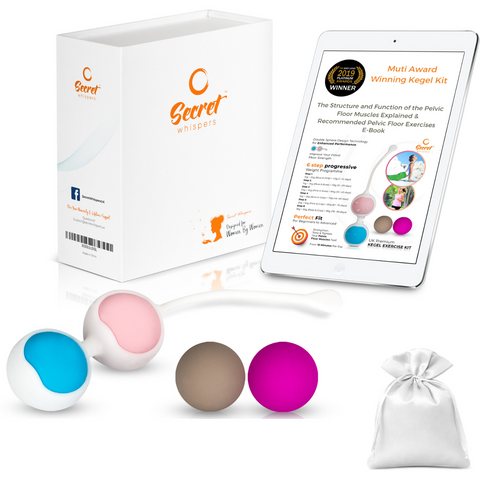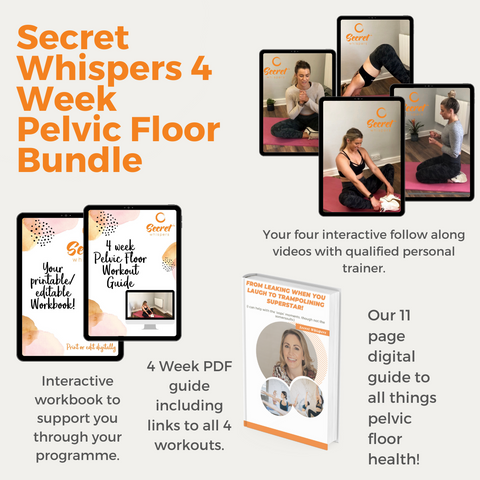Haemorrhoids and Pelvic Floor: What’s The Link?

Haemorrhoids, also known as piles, are a common condition that affects millions of people worldwide. This condition occurs when the veins in the anus or rectum become swollen and inflamed, causing discomfort, pain, and bleeding.
While there are many causes of haemorrhoids, recent research has shown that pelvic floor dysfunction can contribute to the development of this condition.
In this blog post, we will explore the link between haemorrhoids and pelvic floor dysfunction, as well as provide exercises to help prevent or treat this condition.
What Are Haemorrhoids?
Haemorrhoids, also known as piles, are swollen veins in the anus or rectum that can cause pain, discomfort, and bleeding.
There are two types of haemorrhoids: internal and external.
Internal haemorrhoids occur inside the rectum and usually cause bleeding without pain.
External haemorrhoids occur outside the anus and can cause pain and discomfort, especially during bowel movements.
The most common causes of haemorrhoids include constipation, diarrhoea, pregnancy, obesity, and a sedentary lifestyle.
Haemorrhoids are usually not serious and can be treated with lifestyle changes, such as a high-fiber diet, drinking plenty of water, and avoiding prolonged sitting.
What Are The Symptoms Of Haemorrids?
Piles, also known as hemorrhoids, can manifest with several symptoms. Here are some common signs to look out for:
-
Rectal Bleeding: Bright red blood on toilet paper, in the toilet bowl, or on stool can indicate the presence of piles. However, it's important to consult a healthcare professional to rule out other potential causes of rectal bleeding.
-
Anal Itching and Irritation: Persistent itching and discomfort around the anus may occur due to piles. This can be caused by the mucus discharge produced by hemorrhoids.
-
Pain or Discomfort: Piles can be painful, especially during bowel movements. You may experience aching, soreness, or a feeling of fullness in the rectal area.
-
Swelling and Lump Formation: Hemorrhoids can cause swelling and the formation of soft lumps around the anus. These lumps may be sensitive or painful to the touch.
-
Leakage of Stool: In some cases, piles can lead to the inability to fully control the passage of stool, resulting in fecal leakage.
-
Anal Bleeding during Bowel Movements: Straining during bowel movements can cause the piles to bleed, leading to blood in the toilet bowl or on toilet paper.
What are the Different Stages of Piles?
Piles, or hemorrhoids, are categorized into different stages based on their severity and degree of prolapse. The stages of piles are as follows:
-
Stage 1: In the initial stage, piles are internal and not prolapsed. They are located inside the rectum and may not cause any noticeable symptoms. However, there might be occasional bleeding during bowel movements.
-
Stage 2: At this stage, piles may prolapse (bulge) during bowel movements, but they retract back inside the rectum spontaneously. Prolapsed piles can cause discomfort, itching, bleeding, and a feeling of incomplete evacuation.
-
Stage 3: Prolapsed piles at this stage require manual repositioning. They protrude outside the anus during bowel movements and need to be pushed back manually. Symptoms such as bleeding, pain, itching, and discomfort become more prominent.
-
Stage 4: Piles at this advanced stage are prolapsed and cannot be pushed back inside the rectum. They remain outside the anus and may cause significant discomfort and pain. It is common to experience bleeding, itching, swelling, and difficulty in cleaning the area.
Can Pelvic Floor Dysfunction Cause Haemorrhoids?
Pelvic floor dysfunction can cause haemorrhoids by putting pressure on the veins in the anus and rectum. The pelvic floor muscles are responsible for supporting the organs in the pelvic region, including the bladder, uterus, and rectum. When these muscles are weak or dysfunctional, they can cause problems with bowel and bladder control, as well as contribute to the development of haemorrhoids.
One of the most common causes of pelvic floor dysfunction is pregnancy and childbirth. During pregnancy, the weight of the growing baby can put pressure on the pelvic floor muscles, causing them to stretch and weaken. This can lead to problems with bowel and bladder control, as well as contribute to the development of haemorrhoids.
In addition, childbirth can cause trauma to the pelvic floor muscles, which can further weaken them and contribute to the development of haemorrhoids.
Other causes of pelvic floor dysfunction include chronic constipation, obesity, chronic coughing, and certain medical conditions such as multiple sclerosis and Parkinson’s disease.
If you are experiencing symptoms of pelvic floor dysfunction, such as difficulty with bowel and bladder control, pain during sex, or pelvic pain, it is important to seek medical advice.
Pelvic Floor Exercises for Haemorrhoids
Pelvic floor exercises, also known as Kegel exercises, are a simple and effective way to strengthen the muscles in the pelvic region and improve overall pelvic health. Regular pelvic floor exercises can help prevent and treat haemorrhoids by improving circulation, reducing inflammation, and increasing the tone and strength of the pelvic floor muscles.
Here are some exercises that you can do to prevent or treat haemorrhoids:
Here are three exercises that can be done to improve pelvic floor health and reduce the risk of haemorrhoids.
-
Kegel Exercise
To perform a Kegel exercise, contract the muscles used to stop the flow of urine and wind. Hold the contraction for up to 10 seconds and then release and rest for 5 seconds. Repeat this exercise ten times, three times a day.
- Squats
Squats are a great exercise to strengthen the pelvic floor muscles. Stand with your feet shoulder-width apart and squat down as low as you can. Hold the squat for five seconds and then stand back up. Repeat this exercise ten times, three times a day. -
Bridge Exercise
To perform a bridge exercise, lie on your back with your knees bent and your feet flat on the ground. Lift your hips up towards the ceiling, hold for five seconds, and then lower them back down. Repeat this exercise ten times, three times a day.
These exercises can be done at home, and there are also pelvic floor toners available to help with pelvic floor strengthening.
At Secret Whispers, we offer a range of products to support pelvic floor health, including:
ThePelvic Floor Toner for Women

-
Tailored to Your Needs: Secret Whispers Kegel Weights come in a range of weights and sizes, so you can choose the perfect fit for your body and level of experience. This means you can gradually work your way up to more challenging weights as your pelvic floor muscles become stronger.
-
Easy to Use: Secret Whispers Kegel Weights are incredibly easy to use. Simply insert the weight into your vagina and contract your pelvic floor muscles around it. This provides a targeted workout that helps to strengthen your pelvic floor muscles.
-
Cost-Effective: While there are other pelvic floor exercise products on the market, Secret Whispers Kegel Weights are a cost-effective option. They are reusable and can be used in the comfort of your own home, making them a convenient and affordable choice.
-
Proven Results: Pelvic floor exercises are an effective way to improve pelvic floor muscle strength and alleviate symptoms such as haemorrhoids. Secret Whispers Kegel Weights have been specifically designed to help with these issues and have been proven to provide results.

The 30-day Pelvic Floor Challenge
Click the image below to sign up to be notified first when the next one is.

In conclusion, haemorrhoids are a common and uncomfortable condition that can be caused by pelvic floor dysfunction.
Take control of your comfort and well-being by incorporating simple lifestyle changes, using Secret Whispers Kegel Weights and Kegel exercises into your routine you can improve pelvic health and reduce the risk of developing haemorrhoids.
Don't forget to also:
-
Stay Hydrated: Ensure you drink an adequate amount of water each day to maintain soft and regular bowel movements. Hydration helps prevent constipation, which can worsen haemorrhoids.
-
Increase Fiber Intake: Include fiber-rich foods in your diet, such as fruits, vegetables, whole grains, and legumes. Fiber adds bulk to the stool, making it easier to pass and reducing the strain on your anal area.
-
Avoid Straining: Straining during bowel movements puts unnecessary pressure on the anal area, worsening haemorrhoids. Take your time, and if needed, try using a stool softener or fiber supplement to promote regular and comfortable bowel movements.
-
Practice Good Anal Hygiene: After bowel movements, clean the anal area gently with moist wipes or a bidet instead of using rough toilet paper. This helps prevent irritation and further discomfort.
-
Avoid Prolonged Sitting: Sitting for extended periods can put pressure on the anal area. If your work requires sitting for long hours, take regular breaks and try to incorporate short walks or stretches into your routine.
-
Use a footstool when doing a poo: By elevating your feet on a footstool, you can achieve a more natural and effective position for bowel movements. The more efficient and complete evacuation of the bowels can contribute to regularity and a decreased likelihood of constipation. By reducing the time spent straining on the toilet, you can help prevent the worsening of haemorrhoids and piles.
- Kegel Exercises: Strengthen your pelvic floor muscles with Kegel exercises using our weights. These exercises involve contracting and relaxing the muscles used to control urination and bowel movements. Regular Kegel exercises can help improve blood circulation and reduce symptoms of haemorrhoids.
Let me know in the comments if this blog has helped you.
Never miss another blog again. Sign up now to my weekly Newsletter. You will get a 10% discount code to use too. Just click below ⬇️⬇️⬇️












A really interesting and helpful blog. Until reading this I wasn’t aware there was a connection between the pelvic floor muscles and haemorrhoids. Thanks for the education!
Thank you very helpful, makes sense that haemorrhoids can be connected to pelvic floor function. I’ve been wondering why I seemed to have suffered with these more since having problems with slight prolapse of bladder and rectum. I will up my exercises. X